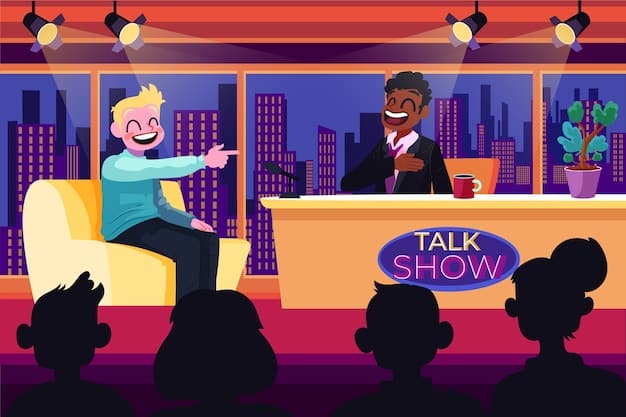Harnessing Humor: The Role of Wit in Effective Communication

Humor in communication serves as a powerful tool for building rapport, enhancing engagement, and fostering deeper connections with an audience by strategically using wit to make messages more memorable and relatable.
In the realm of communication, the ability to connect with your audience is paramount. One of the most effective, yet often underutilized, tools is the strategic use of humor. Understanding the role of humor in communication: Use wit to connect with your audience and build rapport, can transform mundane interactions into engaging and memorable experiences.
Understanding the Essence of Humor in Communication
Humor is more than just telling jokes; it’s about using wit, irony, and lightheartedness to create a connection. It’s an art form that, when mastered, can significantly enhance your communication skills. But why exactly is humor so effective?
The Psychology Behind Humor
At its core, humor taps into our emotional responses. When someone makes us laugh, it releases endorphins, which are natural mood boosters. This positive emotional state makes us more receptive to the communicator and their message. Moreover, humor can disarm people, making them more open to new ideas and perspectives.
Breaking Down Barriers
One of the most significant benefits of humor is its ability to break down social barriers. In professional settings, humor can humanize leaders and make them more approachable. In personal interactions, it can ease tension and build trust. When used appropriately, humor can create a sense of camaraderie and shared experience.

Here are a few key ways humor bridges gaps:
- Reduces formality: Humor can make interactions less stiff and more relaxed.
- Encourages openness: A lighthearted approach can make people more willing to share their thoughts and ideas.
- Fosters inclusivity: Shared laughter creates a sense of belonging and connection.
In conclusion, understanding the psychological and social benefits of humor is the first step in harnessing its power. By recognizing how humor affects our emotions and interactions, we can begin to use it strategically to enhance our communication skills.
The Do’s and Don’ts of Using Humor
While humor can be a powerful tool, it’s essential to use it judiciously. There’s a fine line between being funny and being offensive, and crossing that line can have serious consequences. So, what are the do’s and don’ts of using humor in communication?
The Golden Rules of Humor
First and foremost, know your audience. What might be hilarious to one group could be offensive to another. Consider the cultural background, values, and sensitivities of your listeners or readers. When in doubt, err on the side of caution.
Dos of Using Humor
Here are some guidelines to keep in mind to ensure your humor is well-received:
- Be authentic: Genuine humor is always more effective than forced jokes.
- Keep it relevant: Make sure your humor relates to the topic at hand.
- Use self-deprecating humor: Laughing at yourself can make you more relatable.
- Be positive: Focus on lighthearted and uplifting humor.
Don’ts of Using Humor
On the flip side, here are some pitfalls to avoid to prevent your humor from backfiring:
- Avoid offensive jokes: Steer clear of humor that is sexist, racist, or otherwise discriminatory.
- Don’t be sarcastic: Sarcasm can be easily misinterpreted, especially in written communication.
- Avoid controversial topics: Politics, religion, and other sensitive subjects are best avoided.
Ultimately, the key to using humor effectively is to be mindful and respectful. By following these do’s and don’ts, you can leverage the power of humor to build rapport and connect with your audience in a positive way.
Practical Techniques for Incorporating Humor
Now that we’ve covered the theory and etiquette of humor, let’s delve into some practical techniques for incorporating it into your communications. Whether you’re giving a presentation, writing an email, or leading a meeting, there are various ways to inject humor effectively.
Storytelling with a Twist
One of the most engaging ways to use humor is through storytelling. People love to hear stories, and a well-placed humorous anecdote can make your message even more memorable. The key is to find stories that are relevant to your topic and that have a humorous twist.
Using Anecdotes Effectively
When telling a humorous story, keep these points in mind:
- Keep it brief: Get to the punchline quickly.
- Use vivid language: Paint a clear picture for your audience.
- Deliver the punchline with impact: Timing is everything.
Self-Deprecating Humor
Another effective technique is self-deprecating humor. Laughing at your own mistakes or shortcomings can make you appear more relatable and human. However, it’s important to strike the right balance. You don’t want to undermine your credibility or come across as insecure.

When using self-deprecating humor:
- Focus on minor flaws: Don’t highlight major weaknesses.
- Keep it lighthearted: Avoid being overly critical of yourself.
- Be genuine: Make sure your humor feels authentic.
In conclusion, incorporating humor into your communications involves a blend of storytelling, anecdotes, and self-deprecating humor. By mastering these techniques, you can make your messages more engaging and build stronger connections with your audience.
Humor in Different Communication Contexts
The effectiveness of humor can vary greatly depending on the context. What works in a casual conversation might not be appropriate in a formal presentation. Understanding how to adapt your humor to different communication settings is crucial for success.
Professional Settings: Striking the Right Balance
In professional environments, it’s essential to strike a balance between being humorous and maintaining professionalism. Humor can be a great way to build rapport with colleagues, but it’s important to avoid being too informal or irreverent.
Online Communication: Navigating Nuance
Online communication presents its own set of challenges when it comes to humor. Without the benefit of facial expressions and body language, it’s easy for jokes to be misinterpreted. Here are some tips for using humor effectively online:
- Use emojis and emoticons: These can help convey tone and intent.
- Be clear and concise: Avoid ambiguity in your humor.
- Get feedback: Before posting something humorous, consider getting a second opinion.
Public Speaking: Engaging Your Audience
Humor can be a powerful tool for engaging your audience during a public speaking event. A well-placed joke or humorous story can capture their attention and make your message more memorable.
In conclusion, adapting to using humor in diverse settings requires sensitivity and awareness. Therefore, humor should be thought of contextually!
The Cultural Sensitivity of Humor
Humor is deeply rooted in culture, and what is considered funny in one culture might be completely lost—or even offensive—in another. Cultural sensitivity is paramount when using humor, especially in today’s globalized world.
Understanding Cultural Differences
Before using humor with an audience from a different cultural background, take the time to research their values and sensitivities. What topics are considered taboo? What types of humor are generally appreciated?
Stereotypes and Misunderstandings
Stereotypes are a common pitfall when using humor across cultures. Relying on stereotypes can lead to misunderstandings and offense, even if your intentions are good. Here are some strategies to ensure cultural sensitivity:
- Avoid making assumptions: Don’t assume that everyone shares your sense of humor.
- Be respectful: Show sensitivity towards cultural norms and values.
- Seek feedback: If possible, get input from someone who is familiar with the culture.
Navigating Global Communication
In the world of workplace, being culturally sensitive is crucial. When communicating with international colleagues, humor must be considered thoughtfully. By being mindful of cultural norms and values, you can use humor effectively to create connections and foster understanding in global professional circles.
Measuring the Impact of Humor
Finally, it’s important to measure the impact of your humor to ensure that it’s having the desired effect. How do you know if your humor is resonating with your audience? What metrics can you use to gauge its effectiveness?
Gathering Feedback
One of the simplest ways to measure the impact of your humor is to ask for feedback. Encourage your audience to share their thoughts and reactions. Did they find your humor funny? Did it enhance their understanding of the message?
Tracking Engagement Metrics
In online communication, you can track engagement metrics such as likes, shares, comments, and click-through rates. These metrics can provide valuable insights into how your humor is being received.
Here are some additional metrics to consider:
- Audience Surveys: Collect direct feedback via surveys during and after your communications.
- Social Media Monitoring: Track audience impressions on different social channels.
Adjusting Your Approach
If you find that your humor isn’t landing as intended, be prepared to adjust your approach. Pay attention to the cues from your audience and be willing to experiment with different types of humor.
| Key Point | Brief Description |
|---|---|
| 😂 Essence of Humor | Humor builds emotional connections and breaks down communication barriers. |
| ✅ Humor Do’s & Don’ts | Be authentic and relevant, avoid offensive jokes and sarcasm. |
| 🗣️ Practice Techniques | Use storytelling, anecdotes, and self-deprecating humor. |
| 🌎 Be Culturally Aware | Assess the cultural implications and norms of different groups to improve the effects of you humor! |
FAQ Section
▼
The primary benefit is building rapport and making messages more memorable. Humor engages audiences, making them more receptive to the information being conveyed.
▼
Know your audience and avoid topics that are sexist, racist, or otherwise discriminatory. Steer clear of sarcasm and controversial subjects to prevent misinterpretations.
▼
Use storytelling with a twist, include relevant anecdotes, and apply self-deprecating humor. Ensure your jokes are genuine and align with the context of your communication.
▼
Online communication lacks non-verbal cues, so use emojis to convey tone. In-person communication allows for better gauging of reactions and adapting your humor accordingly.
▼
Humor is cultural, and what’s funny in one culture might be offensive in another. Research your audience and avoid making assumptions that could lead to misunderstandings or offense.
Conclusion
In conclusion, the strategic use of humor in communication holds immense power for building rapport, enhancing engagement, and creating memorable experiences. By understanding the psychology behind humor, adhering to its do’s and don’ts, and adapting your approach to different contexts and cultures, you can effectively harness wit to connect with your audience and foster meaningful relationships.





